
LAST MEETING OF THE SCHOOL YEAR
| June 4 | (Tuesday) | Museum of Science and Industry -- Ruth Goehmann |
ANNOUNCEMENTS…
…Physics Day at Great America is May 7 and 8. They need help. Contact Ann Brandon, llbrandon@aol.com.
…the John Rush Award will be given at the June 4 Museum meeting.
The award is in memory of John Rush, who used phenomena which students
hadn't experienced, to aid in inspiring them in physics. The award is given
to one of our members who has made mind-catching and useful contributions
to the group. Past recipients have been:
| 1983 | Jim Williams | 1984 | Chris Chiaverina | 1985 | Earl Zwicker |
| 1986 | John Milton | 1987 | Gerry Lietz | 1988 | Steve Luzader |
| 1989 | Bill Blunk | 1990 | Larry Alofs | 1991 | Art Schmidt |
| 1992 | Tom Senior | 1993 | Jim Szeszol | 1994 | Ann Brandon |
| 1995 | Roy Coleman | 1996 | Pete Insley | 1997 | Bill Conway |
| 1998 | Bill Shanks | 1999 | Paul Dolan | 2000 | Nick Drozdoff |
| 2001 | Bailey Donnally |
The committee this year is Bill Blunk, Paul Dolan, Nick Drozdoff and Bailey Donnally. Send them your nominations!
AT OUR LAST MEETING…
…We were welcomed to Lake Forest College by Mike Kash and his physics department colleagues, Harold Schnyders, Scott Scharpe, Bailey Donnally and Bill Conway.
| After some announcements, Harold Schnyders showed us an array of "super bright" LEDs arranged to spell out "LFC." We were given diffraction gratings and when we looked at the LEDs we saw the entire visible spectrum! Harold provided some technical information and told us that a monochrometer analysis of the spectrum showed a peak at about 450 nm. The device is a blue LED whose light is absorbed by white phosphors, as in a fluorescent lamp, and reradiated across the spectrum. Peak current is 20 mA. A 2.5 V supply with a 100 W dropping resistor, or 9 V, 330 W, was suggested. The giveaway, was then passed out - a superbright LED for each of us! |  |
Earl Zwicker (IIT) brought out a "popper" that we had seen earlier this year at New Trier High School. He proceeded to provide us with a lucid explanation of the forces involved in each of the four cases he demonstrated, with the flexed popper initially up and down on the table top and on a beaker. And of course he involved us in the discussion of the phenomenon.
Bill Blunk (Joliet Central High School) showed us a counterintuitive
phenomenon dating back to meetings at Lake Forest several years ago, first
shown by Ed McNeil. Bill had used a ceramic tile drill to make a
1/4" hole in the bottom of a small bottle. He put his finger over the hole
and filled the bottle with water. When he removed his finger the water
did not run out of the bottle until he pierced the surface tension film
with a nail. Then Bill filled a Pepsi bottle and covered the top with waxed
paper, then turned the bottle over, peeled away the waxed paper, and the
water remained in the bottle until he inserted a nail (well… not on the
first try…). Then he did the same thing with an even larger diameter
bottle! Surface tension seemed to be ruled out. Finally Bill explained
that hidden under the waxed paper was circle of acetate material (overhead
transparency) that was covering the opening. The nail pushed the acetate
cover out of the way!
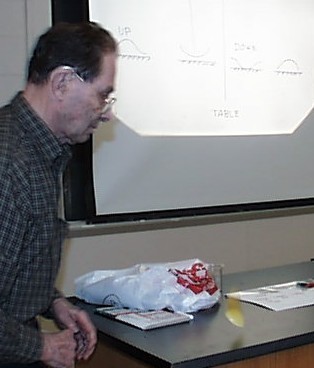
Earl's pepper |
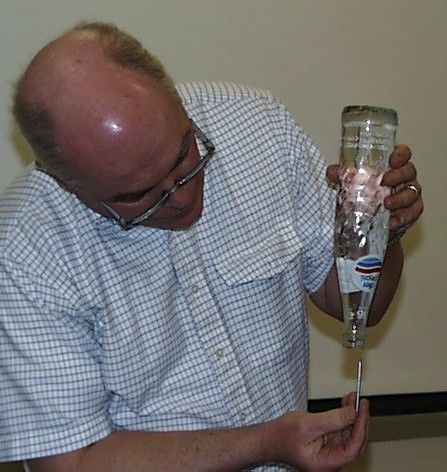
Bill's bottle |
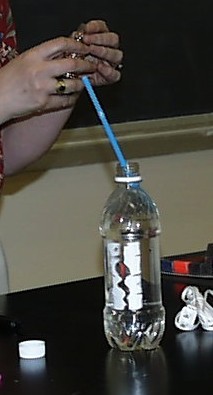
Ann's straw |
Charles Mattes….. passed around a National Geographic gift catalog and noted especially the physics related items, such as a Galileo thermometer, an orery, and a number of holography products. Then he told us of an experience he'd had in Pleasant Prairie, WI, a couple of years ago. He saw as he looked across a lake what looked like an "uneven" horizon and with binoculars thought he saw the tops of trees in Michigan, some 85 miles away. It turned out to be a mirage, a reflection by the atmosphere of the opposite shore of the lake. Harold Schnyders said this is called an "arctic" mirage and requires a large temperature gradient between cold water and warm air.
Ann Brandon (Joliet West High School) showed us a "sinking of
straws" exercise she does with her students to get them thinking about
forces and buoyancy. She seals the bottoms of soda straws with clay
or uses a low temperature hot glue gun ($4 from Michaels). The straws are
placed in water and float at a certain level. The students are asked to
predict how many BBs (from Wal-Mart) can be put in a straw before it will
sink four more centimeters. Our guesses ranged from one to ten. We
saw that four were needed.
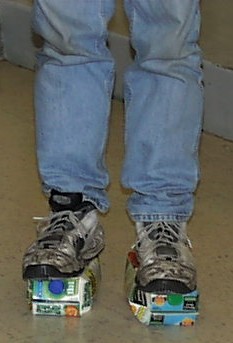 |
Bill Conway had two empty half gallon orange juice cartons and showed us how to use them to illustrate air pressure. He put them on the floor, capped, and asked someone to stand on them. Joe Hermanek (NEIU) volunteered. The cartons flattened a little but supported Joe. Bill uncapped the cartons and when Joe stepped on them the air was forced out and they flattened completely. The Bill blew into the cartons to reinflate them and capped them. Once again they supported Joe's weight. Bill showed us some toys from Burger King that connected in "Rube Goldberg" fashion and could illustrate a sequence of energy conversions. | 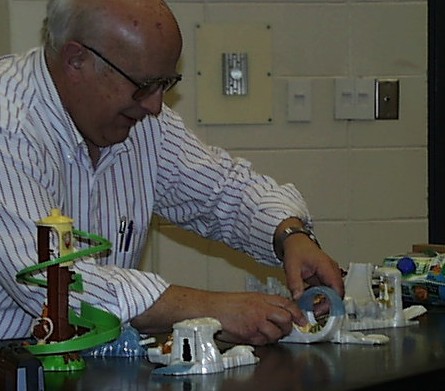 |
Tom Senior (New trier High School) demonstrated a version of the familiar speed of sound experiment using resonance in a tube. Plastic tubes used to protect fluorescent bulbs come in 8 foot lengths at home supply stores and can be cut to shorter lengths. One end is capped with a PVC end cap and the tube filled with water. A smaller diameter tube inserted into the larger tube can be moved up and down to change the length of the sound path. Instead of a tuning fork a piezo buzzer connected to a 9 V battery is used as a sound source. Small diameter plastic tubing goes from the buzzer to the top of the tube; this attenuates the sound. Resonance lengths can then be found. Tom modified this familiar experiment to eliminate the water. He found that a cap from a water bottle fits nicely inside the tube.
| He put the cap at the end of a wooden rod and moved it along the length of the tube to locate the positions of the resonances, one half wavelength apart. He used a Radio Shack dB meter to find the frequency of the buzzer. The output of the dB meter to a $39 DVM that has a frequency scale. The buzzer frequency is about 3.51 kHz. Tom gave us a handout of the old "wet" version. | 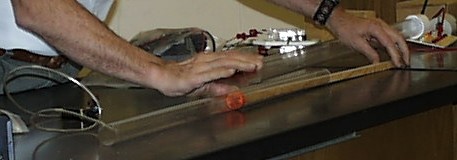 |
| JOB OPENING -- Fremd High School, Palatine,
is looking for a physics teacher. Contacy Bob Grimm, (847) 755-2600. |
Submitted by John Milton
BRING FRIENDS! BRING IDEAS!! SEE YOU AT LAKE FOREST COLLEGE!!!
| Art Schmidt | Jan Dudzik | Earl Zwicker |
| Bailey Donnally | Bill Conway | Mike Kash |
| Ann Brandon | Paul Dolan | Ruth Goehmann |
| Tom Senior | David White | David White |
| Kate Cleary/Van Bistrow | Chris Chiaverina | Gerry Lietz |
| Earl Swallow | Roy Coleman | Kevin McCarron |
| Coordinators: | Paul Dolan |
| Gerry Lietz | |
| Earl Zwicker |
| ISPP Authors: | Gerry Lietz | Data Base Managers: | Roy Coleman |
| Art Schmidt | Earl Zwicker | ||
| John Milton | |||
| Pete Insley |
| Photographers | Paul Dolan | Treasurers: | Ann Brandon |
| Art Schmidt | Pete Insley | ||
| Gerry Lietz | |||
| John Milton | |||
| Earl Zwicker |